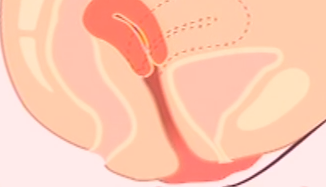An anteverted uterus is a tipped uterus, that is, one which tilts forward. It is different from a retroverted uterus which exhibits a backward tilt.
It may be noted that the uterus consists of 2 parts, the fundus or the upper area of the uterus and the lower cervix. The fundus may sometimes be larger in women who have been pregnant and delivered a baby, while it tends to be smaller, during menopause, in women who have never become pregnant. The cervix measures about 2 inches or sometimes even more. The uterus occurs on the top and is about the size of a pear. The body of the uterus and the cervix join the sidewalls of the pelvis with the help of many ligaments. These ligaments are slightly flexible and allow for a minor forward or backward tilt of the uterus. If a woman has had 2 or more vaginal deliveries, then the ligaments tend to be more flexible as compared to women who have never given birth to a child.

The presence of a slightly forward tilting or anteverted uterus is considered normal. In such cases, the uterus typically flexes to the side of the bladder. However, neither forward nor backward type of uterus tilting is an indication of an underlying pregnancy, nor does it affect the capacity of the women to become pregnant.
What is a normal womb or uterus?
The uterus is an organ shaped like a pear and lying snug in the pelvic area. It measures about 5 cm in width, 8 cm in length, and 3 cm in depth. It is made of a thick muscular strong wall and is hollow within. The upper section of the uterus is known as the fundus; it is the place where the fertilized egg develops into a fetus and then a baby. The lower section which is called cervix and passes into the vagina.
When the uterus is tilted backward, i.e., it leans away from the bladder, then it is referred to as a retroverted uterus. When the uterus leans over the bladder, i.e., forwards towards and over the top part of the bladder, then it is known as an anteflexed or an anteverted uterus. Both these positions of the uterus are not thought to be abnormal as it does not affect the structure of the organ but only the way it is positioned or placed in the pelvis.
An anteverted uterus also does not mean that affected women have lesser ability to become pregnant. This is due to the fact that the ability of the sperms to pass into the fallopian tubes via the uterus is not dependent on the manner in which the uterus is placed. Thus, anteverted uterus is just a medical term used by physicians to differentiate between the different types of uterus positioning.
It is believed that about fifty percent of all women tend to feature an anteverted uterus. However, the severity and degree of such a forward tilt of the reproductive system tends to vary from one woman to another. Such differences in the severity and degree of the forward tilt also generally does not adversely affect the gestational period, the normal function of the reproductive system, the fertility, or the general sexual health of the affected woman.
Causes of an anteverted uterus
The exact cause of an anteverted uterus is not known. However, it is known that the body type and anatomy play a role. The pelvic area has ample room and thus body parts can easily move around. The presence of additional empty space, or rubbing of one organ with another can affect the axis and placement of the uterus.
Most female newborns tend to feature a midposed uterus, i.e., it is placed in a straight position. This position can however change, wherein the organ may tilt to any one side, during the normal process of growth and development. Increased pressure from a growing bladder is what usually causes an anteverted uterus. It is more common than the backward tilt, which typically occurs when the uterus is pulled from the rectum.
Sometimes, childbirth or pregnancy can trigger the uterus to attain a forward tilt. Even though the uterus expands and stretches to accommodate and create space for the growing baby, the associated pressure that is exerted as well as the baby’s position can result in tilting or tipping.
It is also possible for the ligaments to become weaker due to the extreme strain of childbirth, which then in turn may fail to hold the organ in place, thereby causing an anteverted uterus. Sometimes, the tilting may disappear and the organ may revert to its original midposed position after it has healed post childbirth. But sometimes, the tipping may be permanent and there is no reversal of the positioning of the organ to its original place.
With older age, the ligaments and muscles tend to become weaker and softer and thus are unable to hold the uterus in its normal position, thereby causing an anteverted uterus. Thus, the condition is more common in older women than younger ones.

I have anteverted uterus this ll affect my pregnancy
Nope! Shouldn’t affect your pregnancy @Dolly.That’s gking by the article
Nope! Shouldn’t affect your pregnancy @Dolly.That’s going by the article